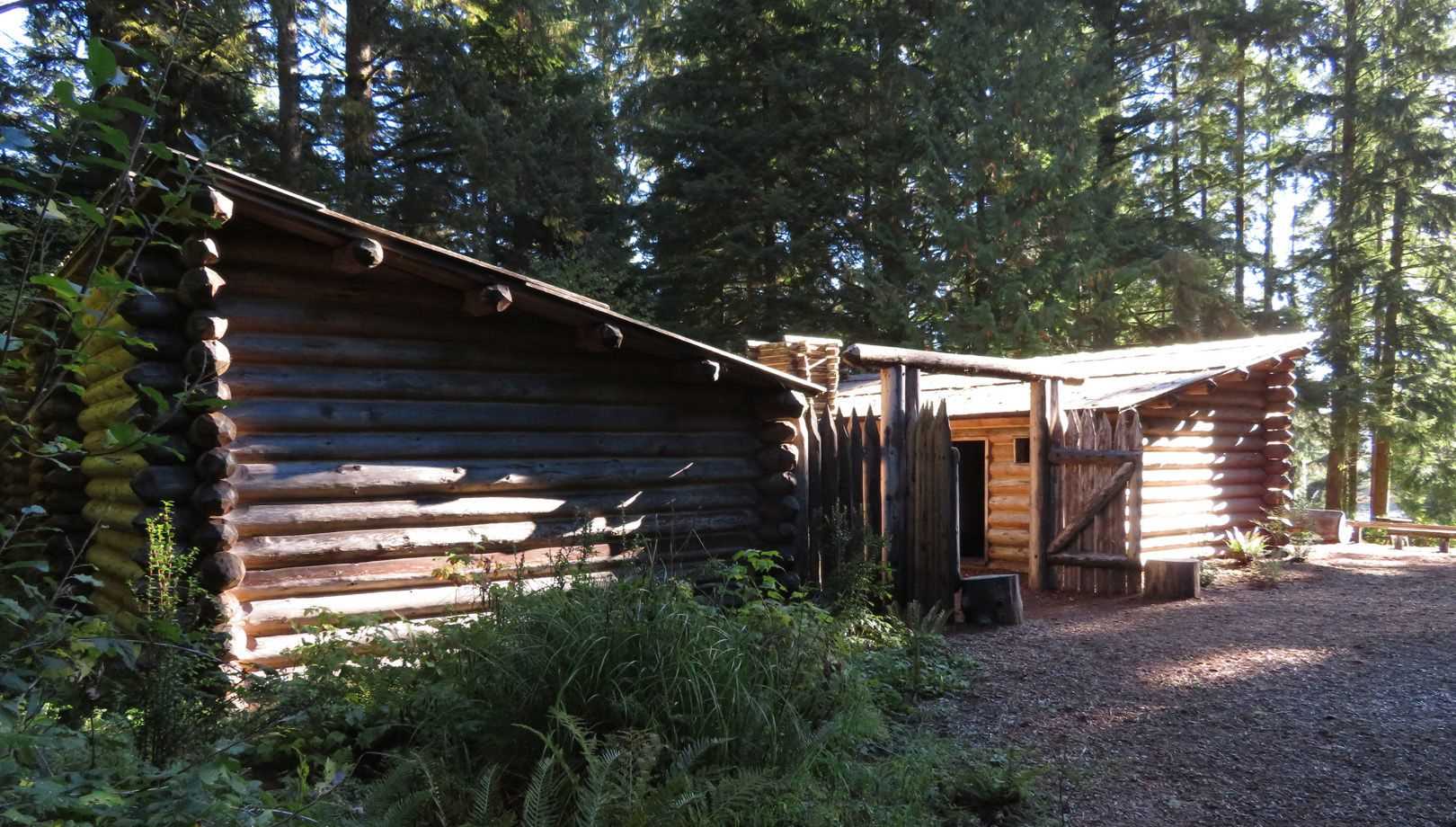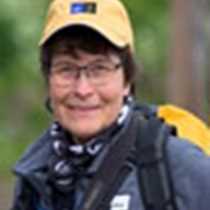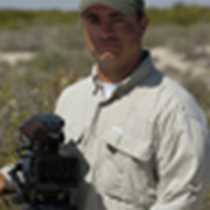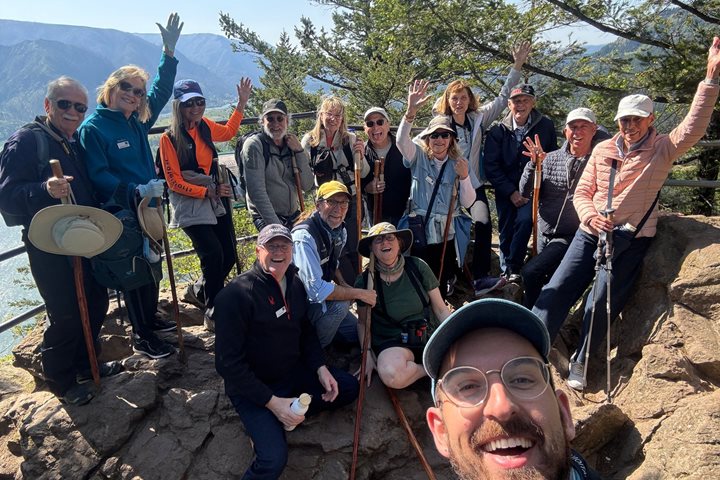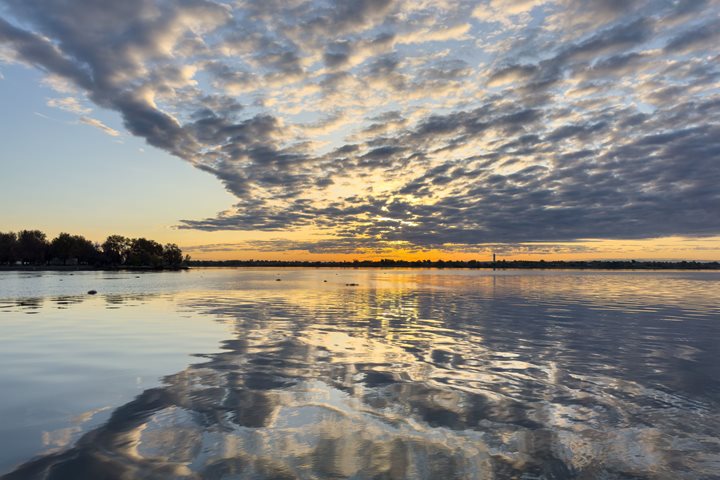The sky was full of stars just before dawn as the National Geographic Sea Lion approached the deepwater port of Astoria. The constellations of Orion, the Mighty Hunter; Taurus, The Bull; and the Pleiades stood high in the south as bright Venus rose over Tongue Point. We were soon docking at a working dock near a huge pile of logs that were being loaded onto an ocean-going ship.
Astoria was the site of the first permanent U.S. settlement on the West Coast where John Jacob Astor’s American Fur Company established Fort Astor in 1811; this only five years after Lewis & Clark and their Corps of Discovery spent the winter of 1805-1806 at Fort Clatsop. The weather this day was fair and warm—the opposite of the, cold, wet, and dreary winter experienced by the Lewis & Clark party. We were soon off to Fort Clatsop where we learned more about the Lewis & Clark party and toured a replica of their fort. Then we took a beautiful walk in the woods—a temperate rain forest with giant Sitka spruce, western hemlock, and western red cedar trees towering above us while huckleberries, salal, and ferns grew beside the trail. We walked down to Canoe Landing and beyond on an inviting trail along the marshy shore of the Netul River. We stopped to watch a great blue heron on the hunt. It curved its long neck close to its chest and stalked its prey in shallow water then struck like lightning, coming up with a small fish. It tossed the fish to turn it and swallowed it headfirst.
The Columbia River Maritime Museum was next, one of the finest maritime museums in the country. Here we learned, among many other things, about the Columbia Bar that is known as The Graveyard of the Pacific. Here thousands of ships have been lost in the treacherous waters created as the Columbia, the Great River of the West, collides with the Pacific Ocean, creating shifting shoals of sand that form the bar. Commander Wilkes of the U.S. Navy, in 1841, wrote that the roaring and tumultuous waters over the bar were “ . . . one of the most fearful sights that can possibly meet the eye of a sailor.”
The afternoon found most of us at Cape Disappointment visiting the Lewis & Clark Interpretive Center that is located on a high bluff of basalt with sweeping views of the mouth of the Columbia River, Cape Disappointment Lighthouse, and the Pacific Ocean. A visit was made to nearby and beautiful Waikiki Beach.
A small group took a guided tour of historic Astoria. This included driving to the top of Coxcomb Hill to visit the Astoria Column from where we enjoyed a panoramic view of the area. A visit was also made to a dock that has been commandeered by hundreds of California Sea Lions. There was much loud barking by these rowdy creatures and jostling for positions on the dock.
On this, the last evening of our voyage, we enjoyed the camaraderie of newfound friends sharing the adventure of sailing together on these great western rivers, the Snake and Columbia. The evening was topped off with our guest slide show that was met with hearty approval by the audience.The sky was full of stars just before dawn as the National Geographic Sea Lion approached the deepwater port of Astoria. The constellations of Orion, the Mighty Hunter; Taurus, The Bull; and the Pleiades stood high in the south as bright Venus rose over Tongue Point. We were soon docking at a working dock near a huge pile of logs that were being loaded onto an ocean-going ship.
Astoria was the site of the first permanent U.S. settlement on the West Coast where John Jacob Astor’s American Fur Company established Fort Astor in 1811; this only five years after Lewis & Clark and their Corps of Discovery spent the winter of 1805-1806 at Fort Clatsop. The weather this day was fair and warm—the opposite of the, cold, wet, and dreary winter experienced by the Lewis & Clark party. We were soon off to Fort Clatsop where we learned more about the Lewis & Clark party and toured a replica of their fort. Then we took a beautiful walk in the woods—a temperate rain forest with giant Sitka spruce, western hemlock, and western red cedar trees towering above us while huckleberries, salal, and ferns grew beside the trail. We walked down to Canoe Landing and beyond on an inviting trail along the marshy shore of the Netul River. We stopped to watch a great blue heron on the hunt. It curved its long neck close to its chest and stalked its prey in shallow water then struck like lightning, coming up with a small fish. It tossed the fish to turn it and swallowed it headfirst.
The Columbia River Maritime Museum was next, one of the finest maritime museums in the country. Here we learned, among many other things, about the Columbia Bar that is known as The Graveyard of the Pacific. Here thousands of ships have been lost in the treacherous waters created as the Columbia, the Great River of the West, collides with the Pacific Ocean, creating shifting shoals of sand that form the bar. Commander Wilkes of the U.S. Navy, in 1841, wrote that the roaring and tumultuous waters over the bar were “ . . . one of the most fearful sights that can possibly meet the eye of a sailor.”
The afternoon found most of us at Cape Disappointment visiting the Lewis & Clark Interpretive Center that is located on a high bluff of basalt with sweeping views of the mouth of the Columbia River, Cape Disappointment Lighthouse, and the Pacific Ocean. A visit was made to nearby and beautiful Waikiki Beach.
A small group took a guided tour of historic Astoria. This included driving to the top of Coxcomb Hill to visit the Astoria Column from where we enjoyed a panoramic view of the area. A visit was also made to a dock that has been commandeered by hundreds of California Sea Lions. There was much loud barking by these rowdy creatures and jostling for positions on the dock.
On this, the last evening of our voyage, we enjoyed the camaraderie of newfound friends sharing the adventure of sailing together on these great western rivers, the Snake and Columbia. The evening was topped off with our guest slide show that was met with hearty approval by the audience.

